|
|
Director's Letter
 | |
I can't think of too many exhibitions more profound--emotionally, spiritually, technically--than Rembrandt and the Face of Jesus. The challenge of negotiating loans came to seem minor as DIA curatorial and interpretive staff sorted through the various possible approaches to a complicated story involving issues that ranged from the deeply personal to the historically global. It is difficult to go through this exhibition without thinking of the Holocaust and wondering how one nation, over centuries, so consistently demonstrated unprecedented political and religious tolerance, while neighboring nations equally consistently yielded to the imperatives of order and control. Not that it was all sweetness and light in mid-seventeenth-century Holland. Within each community, majority and minority, discipline was exercised to keep members on the straight and narrow. Even though she lived with one of Europe's most famous artists, Rembrandt's live-in companion, Hendrickje, was summoned by the state Calvinist church to answer for her immoral ways. A leading figure in the Jewish community, depicted by Rembrandt, was involved in the excommunication of the great philosopher Baruch Spinoza. In (admittedly) unusually contentious circumstances, a leading Dutch patrician was murdered by opponents seeking to weaken the control of the upper class. Nevertheless, this was an unprecedentedly liberal society with a tolerant structure that unleashed extraordinary creative and economic forces.
Our next major exhibition, opening in October, tells a completely different story. Fabergé: Designing Luxury, from the Virginia Museum of Fine Arts presents amazing objects that were the visual manifestation of a society in which wealth and political rights were as inequitably spread as in any society in history, the political and judicial systems came down to the word and attitudes of a single person (the czar), and where artistic production was carefully monitored (art students wore uniforms!). The enormous wealth possessed by the upper echelons of Russian society allowed its members to live in unimaginable luxury that extended from French dessert wines delivered in specially commissioned cut-glass bottles to the masterpieces of intricacy that came from Carl Fabergé's workshop--the eggs, tiaras, brooches, and necklaces; the lockets, picture frames, and cigarette holders. The ineradicable backdrop to this story is, of course, the Russian Revolution of 1917. We know exactly what's going to happen to these people whose faces we see housed within the lockets and picture frames. It's hard not to feel sorry for them, to see them, rather than the long-suffering Russian people, as victims, which they remained for the seven decades following the disastrous Bolshevik takeover in 1918. In presenting these particular artworks, the tension is not between one religion and another, or between realism and imagination; the tension lies in the nature and position of those for whom these objects were made. On the one hand, Czar Nicholas II was a loving husband and doting father. On the other, he was an absolute monarch who effectively dismissed all manifestations of his peoples' discontent as being no more than incipient rebellion and who basically allowed the reformist efforts of his ministers to be undermined by the nobility. I personally do not find them to be very sympathetic people, but the objects we will be seeing only came about because of the historical circumstances relating to their lives.
In its own way, the Fabergé exhibition brings to the surface an issue common to much of what art museums present: art that historically has usually been generated by people or entities of privilege precisely to demonstrate their wealth and status or to express the appropriate nature of their power. In one way, the modernist movement can be viewed as one effort after another to liberate art from the "clutches" of wealth and power. From Courbet to Warhol, artists have sought to eliminate the line separating art from life and, while some things have changed, the current stratospheric prices being paid for art made yesterday and today would seem to indicate that the spirit of Fabergé remains as potent as it was in 1910.

Graham W. J. Beal
Back to top |
|
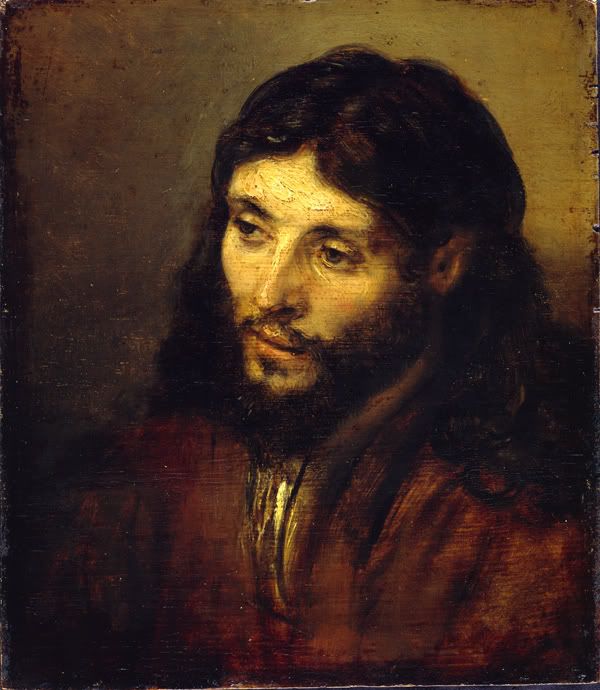
Exhibitions
 Rembrandt and the Face of Jesus Rembrandt and the Face of Jesus
November 20, 2011-February 12, 2012
Special Exhibition Galleries: South
When Rembrandt declared bankruptcy in the mid-1650s, one of the works that appeared on a household inventory was "Head of Christ, done from life," something that was clearly an impossibility. As the DIA's television spot for the exhibition points out, no one knows what Jesus looked like. The inventory notation likely means that Rembrandt created the painting using a model, probably someone from Amsterdam's Jewish community where the artist lived.
Of the small oil sketches of Jesus in the exhibition, scholars believe the version from Berlin is the only one with sufficient art historical and scientific information to have been painted by Rembrandt and not one of his students or followers. The master's touch is evident in the loose, sketchy brushstrokes and the highlighting of the facial features in a way that magnifies the sense of a young man in deep, quiet introspection.
Determining which works were painted by Rembrandt and not members of his studio has always been a difficult and controversial task. Even the official Rembrandt Research Project, charged with authenticating the artist's works, has changed its mind over the decades. The DIA's Head of Jesus, part of the exhibition, is one of eight paintings in the museum identified as being by Rembrandt or his studio. Over the years, the individual attributions have changed. "Some days we own more Rembrandts than others," says DIA Curator of European Paintings Salvador Salort-Pons. "We used to own five, but now we own three. At one time, we owned only one."
Click here for information about a related DFT film.
Members see the exhibition free, but complimentary reserved, timed tickets are necessary, available at the DIA Box Office, online at www.dia.org, or by calling 1.866.DIA.TIXS (866.342.8497). Remember, there is no handling or service fee when ordering members' tickets. For more information, call the Membership HelpLine at 313.833.7971. For the general public, timed tickets are $16 for adults and $8 for youth ages 6 to 17. A $3.50 charge applies to nonmember tickets not purchased at the DIA.
Advanced ticket reservations highly recommended. The exhibition has been drawing large crowds and time slots have sold out.
This exhibition has been organized by the Detroit Institute of Arts, the Musée du Louvre, and the Philadelphia Museum of Art. In Detroit, the exhibition is generously supported by The Cracchiolo Family. Additional support has been provided by the City of Detroit.
This exhibition is supported by an indemnity from the Federal Council on the Arts and the Humanities.
Above: Rembrandt van Rijn, Dutch; Head of Christ, ca. 1648-50; oil on oak panel. Staatliche Museen zu Berlin, Gemäldegalerie Back to top
 Detroit Revealed Detroit Revealed
Photographs, 2000-2010
Through April 29, 2012
Albert and Peggy de Salle Gallery of Photography
 | | |
Corine Vermeulen, Dutch; Sweater, Catherine Ferguson Academy, from Your Town Tomorrow, 2007 (printed 2011); pigment print. Museum Purchase, Albert and Peggy de Salle Charitable Trust | |
Meet Sweater, the sheep. Hers is one of the first faces you see when entering the photography gallery. The photograph encapsulates the exhibition's intention: giving visibility to the vibrant, often surprising culture of Detroit and its people that go beyond the widely circulated images of the city's empty buildings.
Sweater lived on the urban farm found at the Catherine Ferguson Academy, a city school for pregnant girls and teen parents, where students learn self-sufficiency through agriculture. Ducks, rabbits, and chickens also inhabit the farm, and an old playground has blossomed with vegetable gardens and an orchard.
Corine Vermeulen took the photograph as part of her series Your Town Tomorrow, documenting her neighbors, alternative urban lifestyles, activism, and everyday Detroit experiences. Originally from the Netherlands, Vermeulen as been a city resident since 2006 and says that her adopted hometown represents "a unique and great vehicle for change, where old structures are no longer in place and the possibilities of something different to happen are endless."
Click here for information on a related DFT film series.
This exhibition has been organized by the Detroit Institute of Arts. Support has been provided by Quicken Loans and Team Detroit. Additional support has been provided by the City of Detroit. Support for the catalogue has been provided by Furthermore: a program of the J. M. Kaplan Fund. Back to top
 Gift of a Lifetime Gift of a Lifetime
The James Pearson Duffy Collection
Through March 18, 2012
Special Exhibitions Central
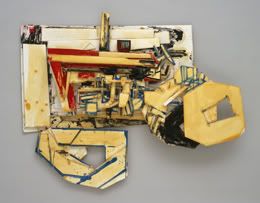 | |
Above: Gordon Newton, American; Untitled (Agriculture), 1987, paint and resin on foamcore, Gift of James Pearson Duffy | |
Over the course of thirty years, James Duffy assembled a large cross-section of work in all mediums by the Cass Corridor artist Gordon Newton, including paintings, sculpture, and more than five hundred drawings. Duffy was to become Newton's principal patron. "I've had so many of his works. I'd see them in the morning when I got up and before I went to bed," the collector said. "Sometimes I'd take my flashlight to see what was going on in the dark. A lot of them can be unattractive on the surface....but you've got to get away from the obvious to figure it out."
A layered drawing from Newton's Agriculture series is indicative of the artist's working methods. It is one of three bas-reliefs and fifteen study drawings from the series that Duffy gave to the DIA. All focus on a tractor, centered in an indeterminate space in the drawings and modeled in low relief out of foam core covered with resin. In the untitled work illustrated here, the innards of the motor are itemized--hoses, gears, belts, pipes, and valves--and the tires angularly rendered as cubistic forms. The rear wheels, projecting two and a half inches into space, are built up of eleven stacked layers of foam core. The artist says his interest in three-dimensional constructions like the tractor lay in "conveying a sense of physicality to the viewer...allowing him to project himself into the pieces in a way that a flat drawing doesn't allow."
Newton likes to work in series, taking on themes that include, in addition to agriculture, warfare, heads, and an English cottage on the Thames, among others, and exploring them through multiple images and media. He says he "wanted to have something I could keep working on everyday in a totally unplanned way over a prolonged period." Back to top
 Once Upon a Time Once Upon a Time
Prints and Drawings that Tell Stories
Through May 13, 2012
Schwartz Galleries of Prints and Drawings
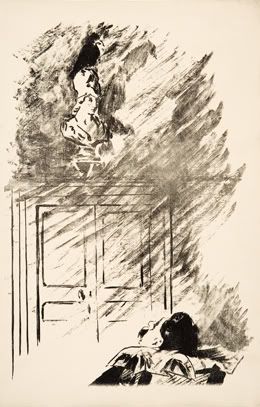 | | |
Edouard Manet, French; Perched upon a Bust of Pallas (Le corbeau sur le buste), 1875; transfer lithograph. Founders Society Purchase, Unrestricted Funds | |
The prints and drawings in this exhibition tell stories that range broadly in authorship from tales and fables by anonymous or barely known writers to some of the world's most recognizable literature, including Edgar Allan Poe's poem The Raven. The mesmerizing appeal of The Raven transcends time and cultures. French artist Edouard Manet created images for a deluxe portfolio published in Paris in 1875 for Stephane Mallarmé's French translation of Poe's poem.
The Raven was first published in the United States in 1845 and was an immediate success. In the poem, Poe describes the visit of a talking bird to a man who is so upset about a broken love affair that he is driven into madness. The bird speaks the name Lenore and the famous refrain "Nevermore." Mallarmé was able to duplicate Poe's cadence and vivid language in his translation, which Manet matched visually in the prints.
Mallarmé began crafting his translation in 1862. He and Manet became acquainted in the early 1870s when the translation was first published. Like Mallarmé, Manet was a great fan of Poe's writing and had been familiar with his work for decades. Their Raven project is considered to be an exceptional achievement because of the strong stylistic linkage between text and imagery. The sketchy, quick-stoke style in which Manet chose to interpret the verses parallels the spontaneity of Poe's words and Mallarmé mimicry in French of the same rapid-fire rhyming schemes.
Among international publications that preceded the Mallarmé French translation and illustrations by Manet was John Tenniel's (of Alice in Wonderland fame) illustrations to a British anthology of Poe's work published in 1858. In 1884 Harper & Brothers of New York issued a lavish edition of the poem with woodcuts by Gustave Doré. Many twentieth-century versions were also produced by other artists. Back to top |
|
New Puppets on View
Through July 1, 2012
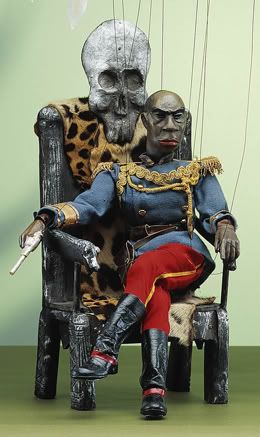
| | |
Ralph Chessé, American; Emperor Jones, 1928;wood, paint, cloth, leather, cord, and gold ribbon. Founders Society Purchase, Paul McPharlin Memorial Fund
| |
Marionettes by Paul McPharlin (1903-48) and his contemporaries are featured in a new exhibition of puppets from the 1920s and 1930s on view in the puppet cases across from the Lecture Hall. McPharlin performed regularly at the DIA during this time with shows as varied as Faust and Krazy Kat: A Jazz Ballet, both represented in the new installation. Stage sets and props from McPharlin's productions and others are also included in the exhibition.
McPharlin was the face of puppetry in the Midwest, particularly Detroit. He created a self-portrait puppet in 1936 to introduce the many puppet plays that he wrote or adapted from other sources. Krazy Kat was based on the characters of George Herriman's comic strip of the same name. McPharlin made the puppets he performed, as well as the stage sets and props. He was a founder of the Puppeteers of America, designed and published more than fifty books on the craft, and taught art and puppetry classes at what is now Wayne State University.
McPharlin and other puppeteers of the 1930s produced shows with support from the Federal Theatre Project, part of the Works Progress Administration (WPA), a government agency organized to support artists during the Depression. Among these puppeteers was Ralph Chessé, who produced adaptations of avant-garde theater, such as Eugene O'Neill's The Emperor Jones. The play tells the story of an African American fugitive named Brutus Jones, who flees the United States to become the emperor of a Caribbean island. Chessé sculpted the puppets with strong, stark features, modeling the title character on Charles Gilpin, the actor who appeared in the original stage production. The complete marionette cast of Emperor Jones is featured, including a giant, puppet-eating alligator.
More about the DIA's puppet collection can be found in Strings, Hands, Shadows: A Modern Puppet History, available in the Museum Shop.
Back to top |
|
 Detroit Film Theatre Detroit Film Theatre
Artists take front and center at the DFT this month with a film one critic called a "unique, immersive museum-meets-cinema experience" and Charles Laughton's 1936 portrayal of Rembrandt. The Mill and the Cross is an exploration of what it would it be like to step inside a great work of art, in this case Pieter Bruegel the Elder's The Way to Calvary. In an extraordinary imaginative leap, the painting comes alive around a visitor, who observes the artist as he sketches the very reality the individual is experiencing. Using sophisticated computer technology, the filmmaker creates a brilliantly complex and fascinating multilayered dreamscape that melds art, history, and religion with the joys and struggles of ordinary people. The Mill and the Cross plays the weekends of January 20 and 27.
In 1936, Laughton (left) teamed up with legendary British producer Alexander Korda for a dramatic, moving, elegantly photographed biographical portrait of the Dutch painter. Beginning when Rembrandt's reputation was at its height, the film tracks his quiet descent into loneliness and isolated self-expression following the death of his wife, to the unveiling of The Night Watch, to the ecclesiastical excommunication of his late-in-life lover and maid, Hendrickje Stoffels (played by Laughton's real-life wife, Elsa Lanchester). Though filmed in black and white, the cinematography by Georges Périnal is accomplished with an attention to light and shadow that does justice to the artist's vision. Rembrandt plays for one showing on Saturday, January 21, at 4 p.m.
The DFT opens the season on January 13 with the Finnish film Le Havre and Man on a Mission. Le Havre is the story of aging shoe-shiner Marcel (Andre Wilms), who creates a temporary safe haven in a small Normandy town for an illegal immigrant (Blondin Miguel). Man on a Mission follows nearsighted Richard Garriott as he strives to fulfill his obsession to go into space, following in the footsteps of his astronaut father, but must turn to to private space travel after NASA turns him down.
In conjunction with the exhibition Detroit Revealed: Photographs 2000-2010, the DFT presents a series of new works by local and international filmmakers that look at the city's past, present, and future. The first of these films, plant (3D). runs continuously near the Special Exhibition Galleries: South on the second floor. The fifteen-minute, three-dimensional film investigates Detroit's abandoned Packard auto plant over a three-day period. Digital artist Paul Kaiser and his partners at OpenEnded Group took more than 10,000 shots that capture the vast enormity and emptiness of the factory while, at the same time, challenging the boundaries of film, photography, and media art. The film, commissioned by the Institute for the Humanities at the University of Michigan, where Kaiser is a visiting artist, runs continuously Friday, January 20, through Sunday, February 5, beginning at 1 p.m. until one hour prior to the museum closing.
Listen to the DFT's Elliot Wilhelm discuss the upcoming season with WDET's Craig Fahle or watch him chat with Fox News' Lee Thomas. For the complete DFT schedule, call the theater box office at 313.833.3237 or visit the DIA's website.
The plant (3D) presentation is made possible with the generous support of the Institute of the Humanities, University of Michigan, Ann Arbor. Back to top |
|
 Special in January Special in January
More Rembrandt, the Packard Plant, and Armor
Look for a number of special activities this month complementing special exhibitions, as well as a family performance related to the DIA's arms and armor collection.
For Rembrandt and the Face of Jesus exhibition, take advantage of half-price tickets and catch a lecture on the artist's lifelong search for an especially moving image of Jesus on Sunday, January 8. Later in the month, let the music of Sfogati! transport you to the time of Rembrandt. January 8 is the next Ford Free Sunday, when there is no charge for museum admission and tickets for the Rembrandt exhibition are $8 for adults and $4 for ages 6 to 17. (A coupon for $6 off exhibition tickets through January 16 is also available.) At 2 p.m., exhibition catalogue author Shelley Perlove discusses how paintings and prints of biblical narratives reveal Rembrandt's distinctive approach to the life of the Christian savior as a Jew. On January 29, the Sunday Music Bar features soprano Lorna Young Hildebrandt, cornetto player Kiri Tollaksen, and harpsichordist Shin-Ae Chun, the members of Sfogati!, performing divine music from the seventeenth century. Performances are at 1 and 3 p.m.
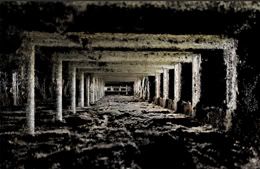 | |
A short film and a lecture highlight two contradictory themes of Detroit Revealed, Photographs 2000-2010: the city's industrial past and the redefinition of Detroit for a brighter future. Plant (3D), a fifteen-minute film playing continuously Friday, January 20, to Sunday, February 5, offers a three-dimensional investigation of Detroit's abandoned Packard auto plant (left), capturing the vast empty factory while challenging the boundaries of film, photography, and media art. On Friday, January 27, Detroit Free Press reporter John Gallagher, an exhibition catalogue contributor and long-time urban observer, looks at Detroit's over abundance of open land, underutilized roads, and empty buildings and discusses how urban agriculture, the restoration of natural landscapes, and the growth of an arts-related economy may redefine the city's future.
 | |
On the weekend of January 20, step back in time as the Michigan Entertainment Renaissance Curiosities Society answers questions about who wore armor and why. Members don period clothing with matching weaponry to demonstrate in a mock battle how different types of arms and armor were used during the Renaissance. The family-friendly event takes place Friday, January 20, at 7:45; Saturday, January 21, at 1 p.m. and 3 p.m.; and Sunday, January 22, at 11 a.m., 2 p.m., and 4 p.m. in the Great Hall, surrounded by the DIA's suits of armor.
All events are free with museum admission with the exception of Rembrandt and the Face of Jesus. Back to top |
|
Martin Luther King, Jr., Day
This year, for the first time, the DIA will be open for Martin Luther King Day with tours of the African American art collection, a special artist demonstration, and other family-friendly activities. The holiday honoring the late civil rights leader is Monday, January 16, and museum hours are 10 a.m. to 4 p.m.
Take a guided tour of the African American art galleries featuring the work of Benny Andrews, Ali McGee, Tyree Guyton, Hughie Lee-Smith, Jacob Lawrence, and many other artists. Tours leave Prentis Court at noon, 1 p.m., and 2 p.m. Or have a custom-made tour created for you by the staff and volunteers at the Family Fitting Room, also in Prentis Court, from 10:30 a.m. to 2:30 p.m.
From noon until 4 p.m., watch as Michigan artist Hubert Massey (above), known for collaborating with communities to create art that tells their stories, demonstrates how he makes frescos. He is one of the few African American artists practicing true fresco technique, which Diego Rivera used when painting his Detroit Industry murals. Massey's Detroit works can be at the Charles H. Wright Museum of African American History, Paradise Valley Park, and Campus Martius.
In addition, visitors of all ages have the opportunity to create a simple book to use for stories, journals, or drawings at a drop-in workshop from 11 a.m. to 3 p.m. All activities are free with museum admission. Back to top |
|
|
|
|
Culture Business
According to the Michigan Economic Development Corporation, the amount of money spent in 2010 on the arts, culture, and history was close to the total expended sum on general tourism and sporting activities.
Crain's Detroit Business reported that while sightseeing accounted for the largest amount at $3.5 billion, tourists and residents spent $2.08 billion to visit arts and cultural organizations and events or about 17 percent of the total $12.6 billion in leisure /tourism dollars. Hunting, fishing, snow skiing, golfing, and other sports and sporting events brought in $2.5 billion in 2010, and visits to Michigan's waterfronts accounted for $2.1 billion. Cultural tourism spending in Michigan increased $262.7 million or 2 percent between 2008 and 2010.
Sixty-eight percent of visitors to the state's cultural institutions were residents who traveled fifty miles or more to reach their destination. To see the full Michigan Economic Development Corporation report, released last fall, click here.
Back to top |
|
|
Detroit Institute of Arts
5200 Woodward Avenue
Detroit, Michigan 48202
www.dia.org
313.833.7900
Comments or questions about the newsletter? Please contact us: comments@dia.org
ADMISSION
$8 adults, $6 seniors, $4 children
The museum is free for members
Contact the Membership HelpLine at
313.833.7971 or membership@dia.org
For group sales (15 or more) contact 313.833.1292 or dia.org/grouptours
CATERING & RENTALS
Call 313.833.1925 or
catering@dia.org |
HOURS
Museum
Mon, Tue CLOSED
Wed, Thur 10 a.m.-4 p.m.
Fri 10 a.m.-10 p.m.
Sat, Sun 10 a.m.-5 p.m.
PARKING
Valet parking is available at the Farnsworth entrance on Fridays, Saturdays, and Sundays, during regular museum hours. The price per car is $8.
Lighted, secure self-parking is available in the Cultural Center parking lot, between John R and Brush, behind the museum.
Ford Free Second Sundays are generously supported by the Ford Motor Company Fund. Next Ford Free Sunday January 8.. |
CaféDIA
313.833.7966
Wed, Thur 11:30 a.m.-2:30 p.m.
Fri 11:30 a.m.-2:30 p.m., 5-9 p.m.
Sat, Sun 11:30 a.m.-3 p.m.
Kresge Court Coffee Stop
Wed, Thur 10 a.m.-3 p.m.
Fri-Sun 10 a.m.-4 p.m.
Museum Shop
313.833.7944
Open during museum hours |
|
|
|
|
|
















